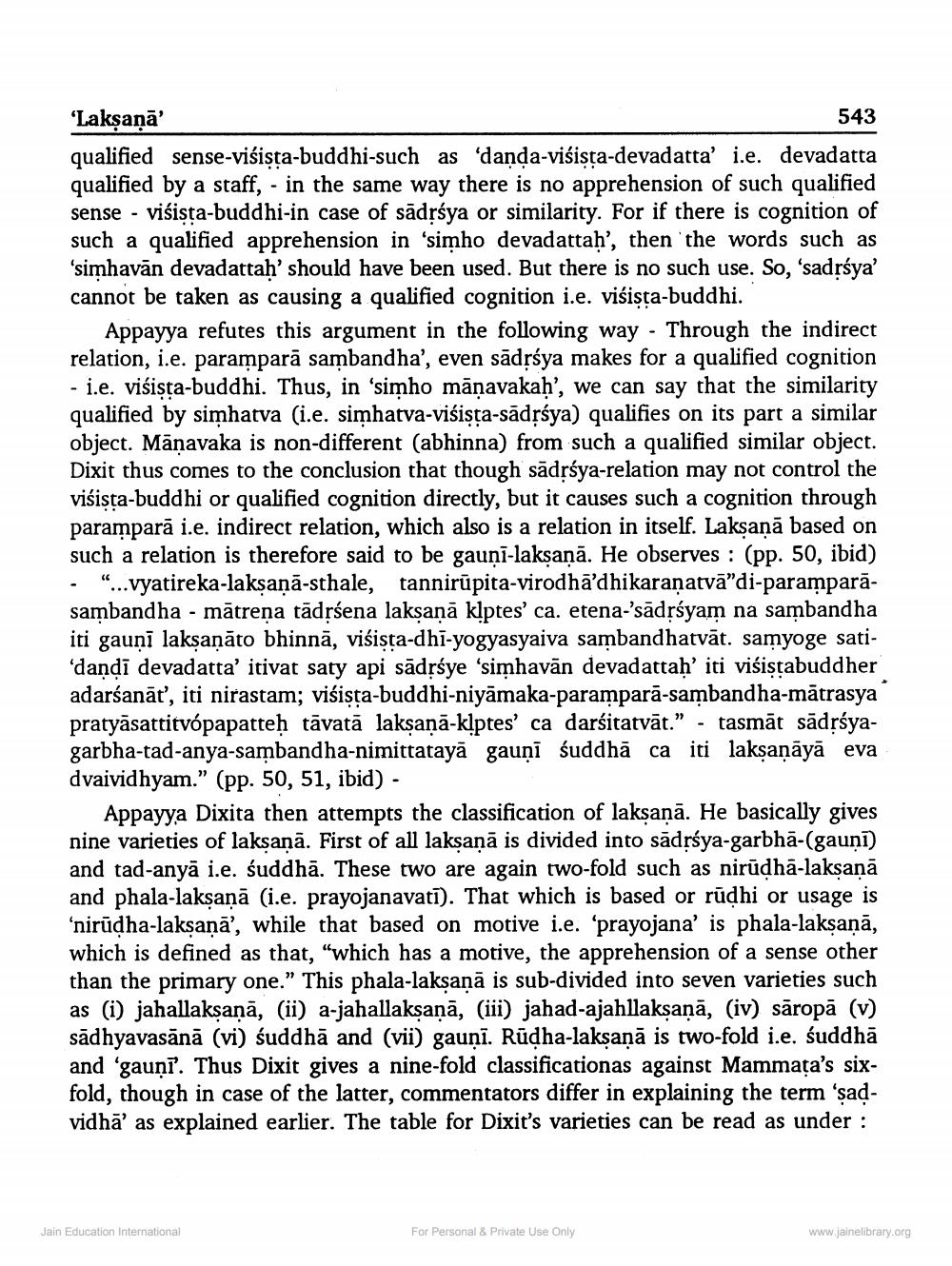________________
'Laksanā'
543 qualified sense-visista-buddhi-such as danda-visista-devadatta' i.e. devadatta qualified by a staff, - in the same way there is no apprehension of such qualified sense - visista-buddhi-in case of sādịśya or similarity. For if there is cognition of such a qualified apprehension in 'simho devadattah', then the words such as 'simhavān devadattah' should have been used. But there is no such use. So, 'sadrśya' cannot be taken as causing a qualified cognition i.e. viśista-buddhi.
Appayya refutes this argument in the following way - Through the indirect relation, i.e. paramparā sambandha', even sadrsya makes for a qualified cognition - i.e. viśista-buddhi. Thus, in ‘simho māņavakah', we can say that the similarity qualified by simhatva (i.e. simhatva-viśista-sādrśya) qualifies on its part a similar object. Māņavaka is non-different (abhinna) from such a qualified similar object. Dixit thus comes to the conclusion that though sadrśya-relation may not control the visista-buddhi or qualified cognition directly, but it causes such a cognition through paramparā i.e. indirect relation, which also is a relation in itself. Laksaņā based on
on is therefore said to be gauni-laksanā. He observes : (pp. 50, ibid) · "...vyatireka-laksanā-sthale, tannirūpita-virodhā'dhikaranatvā"di-paramparāsambandha - mātrena tādrsena laksanā klptes' ca. etena-'sādrśyam na sambandha iti gauni laksanāto bhinnā, visista-dhi-yogyasyaiva sambandhatvät. samyoge sati'dandi devadatta' itivat saty api sādrsye 'simhavān devadattah' iti visistabuddher adarśanāt', iti nirastam; visista-buddhi-niyāmaka-paramparā-sambandha-mātrasya pratyāsattitvopapatteh tāvatā laksanā-klptes' ca darsitatvāt." - tasmāt sādrsyagarbha-tad-anya-sambandha-nimittatayā gauni suddhā ca iti laksanāyā eva dvaividhyam.” (pp. 50, 51, ibid).
Appayya Dixita then attempts the classification of laksanā. He basically gives nine varieties of laksanā. First of all laksaņā is divided into sādrśya-garbhā (gauni) and tad-anyā i.e. suddhā. These two are again two-fold such as nirudhā-laksaņā and phala-laksanā (i.e. prayojanavati). That which is based or rūdhi or usage is ‘nirūdha-laksana', while that based on motive i.e. 'prayojana' is phala-laksaņā, which is defined as that, “which has a motive, the apprehension of a sense other than the primary one." This phala-laksanā is sub-divided into seven varieties such as (i) jahallaksaņā, (ii) a-jahallaksaņā, (iii) jahad-ajahllakṣaṇā, (iv) sāropā (v) sādhyavasānā (vi) suddhā and (vii) gauni. Rūdha-laksanā is two-fold i.e. suddha and 'gauni'. Thus Dixit gives a nine-fold classificationas against Mammata's sixfold, though in case of the latter, commentators differ in explaining the term 'sadvidhā' as explained earlier. The table for Dixit's varieties can be read as under :
Jain Education International
For Personal & Private Use Only
www.jainelibrary.org




